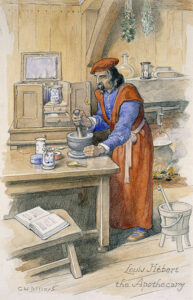Where does all this historic fruit come from?
Louis Hébert (1575-1627) was the first Frenchman to settle permanently with his family in New France, in 1617.
Hébert was an apothecary (the old name for a pharmacist). He became a farmer in New France and is said to have planted the first apple trees in Quebec City.
Cultivating the land and growing fruit trees wasn’t easy. The land had to be prepared since it was covered entirely by forest. The climate was different from that of France and political events occurred, including the British occupation from 1629 to 1632. Most settlers returned to France at that time.
Nevertheless, as the colony grew, orchards began to appear in the landscape. Our ancestors were determined; they brought twigs, small trees and even seeds and pits for sowing with them.
The religious communities who came to New France also took part in fruit-growing. As Paul-Louis Martin explained in reference to the Jesuits, the Récollets, the Sulpicians and women’s religious communities, religious orders attached a symbolic value to fruit crops.
Fruit production was very important, because educating a tree, shaping it and helping it to develop its growth habit and its most productive, elegant and suitable stature, while removing bad stems, was considered to symbolize the way to keep a person’s bad tendencies in check and to thus enable them to become a completely satisfactory person from a religious standpoint. It’s a phenomenon that dates back to the monks of the Middle Ages.
These early orchards rapidly produced apples, plums and pears, not to mention delicious cherries. Documents from the 17th and 18th centuries mention Calville and Saint-Laurent d’hiver apples, Reine-Claude and Damson plums and Bon-Chrétien pears.
If you’re wondering when orchards first appeared on the Côte-du-Sud,
read the following story.


